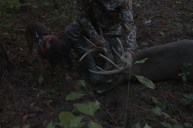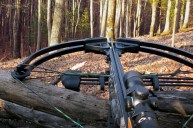After you put all the work in to shoot a big buck, the last thing you want is to lose it after the shot.
It takes many hours and days to scout the best spots, check trail cameras, and wait for that perfect shot every deer season. So, after you make that shot, you can use these 10 tenets as a guide to finding your well deserved deer. Too many hunters neglect the little things when it comes to trailing a wounded deer. However, it's important for deer hunters to know how to follow and anticipate a deer's movements on a blood trail.
Because when it comes to tracking deer, mistakes can be costly and far too many inexperienced hunters lose game animals to the coyotes that should have been easily recovered. In many cases it goes beyond simply knowing whether you had a lung shot or a gut shot.
Before you call in the deer tracking dogs, let's go over 10 key tenements you should use any time you're pursuing an injured whitetail or mule deer. Let's get started with the most important one.
1. Remember Where You Shot the Deer At
This is one of the simplest, yet often forgotten principles of deer hunting. Tracking a deer becomes one hundred times harder if you do not know where to start. I know it sounds crazy, but I have hunted with guys that get excited and just start shooting. Then when we start tracking they say "it was this direction when I shot it".
"This direction" is not nearly as helpful as "next to this tree". You need to pick out a specific land marker. Try to get as specific as you can, it will only help when the tracking starts. It is a good idea to take note of this before the shot, but a few moments after the shot are also good.
2. Give Your Deer Time
After you shoot your deer, you need to give it time to die. First off, injured animals are very dangerous. You do not want to sneak up on a live buck that is willing to gore you to stay alive. More than one hunter has learned that the hard way after tangling with an angry and injured whitetail deer. You should wait at least 30 minutes before attempting to retrieve your deer.
Another benefit is you will not bump your deer as often. This heavily depends on your shot placement. If you made a perfect shot, your deer may fall in its tracks or only run a couple of dozen yards. Although if you made a poor shot, that deer could live for quite a while before it dies.
3. Go to the Shot, Not Where You Last Saw It
This one seems a little obvious, but if you see where your deer falls, or where they went into the wood line it is tempting to just go there immediately. Although I will tell you, it is much better to start at where you shot them every time.
This will lead to more recoveries overall and keep you from making assumptions about where the deer ran during a time when you are filled with adrenaline and excitement.
4. Look For Your Arrow
If you are bow hunting, your arrow can tell you a lot about your shot and how the deer will behave. For starters, you can tell if and how you hit the deer. If your arrow does not have any blood or hair on or around it, then you could have totally missed, or just missed vitals.
Then you can look at the shade of the blood on your arrow. Rich red blood means you got a heart shot, the deer will not go far. Dark red blood means you hit them in the liver, and they will definitely die but it will take a little longer. Pink or bubbly blood means you hit them in the lungs and they will die shortly. On the flip side, if there is little blood, and a putrid smell that indicates a gut shot, you will probably need to give the deer more time.
5. Follow Blood and Other Sign
A big blood trail is nice when tracking, but it is not the only thing you should look for. After all, it is called tracking, not blood following. Look for hair, small pieces of meat, turned up spots on the ground, or broken vegetation. Deer will break through a lot of brush to get away after a shot, if you know how to look at it, you could get a clue as to where they went.
6. The Path of Least Resistance
If you happen to lose blood, and you are relying on the other signs we mentioned above, tracking can oftentimes become a "best guess". There is no way to know for sure which way a deer went after the blood trail dries up.
Although if you are not finding other sign, you can know that wounded animals will always follow the path of least resistance. They are hurting, and want to make the easiest movement possible. In most cases they'd much rather go downhill than uphill. If you find yourself at a crossroads where a deer could have gone multiple directions, your first guess should always be the direction water would flow.
7. Hunt Your Way to the Deer
When you get a good blood trail, it is super exciting. However, you should still take things slow. There is no way to know for sure that your deer is dead before you get to it and see for yourself. If you go walking loudly down the blood trail, you can bump them if the deer is still alive. Hunt your way along when you are tracking. Doing it this way, you will have a better chance at getting another shot if your deer is still alive.
8. Injured Deer Are Smart
It doesn't happen often, but every now and then you will shoot a deer that is going to take a long time to die. Those deer are very smart and they know how to hide very well. When you lose blood and can not find your deer, look in places that you would not normally expect.
They also know that you are after them. When I first started bowhunting, I shot a doe in the top of the back right through the spine. She dropped instantly and began to crawl off with her front feet. She actually got her back feet tied up in some thick vines and briers, so she was stuck. But she got herself into that thick stuff and made it tough to see her.
On top of that, she would also lay her head down when she heard us stop walking. Then would pick it up again when we started walking so she could spot us. They are smarter than most people think. You will need to pull out all the stops to find a deer that is injured, but not yet dead.
9. Check the Water
If you are totally out of ideas and have tried a basic grid pattern search, one more place you can look is the water. If there is a creek or larger body of water around, injured deer will oftentimes go to it.
They do this for the same reason that you run your finger under the sink after you cut it. Water heals, and they know that. They also have a tough time getting out of creeks when injured if the bank is high, so you may find them dead in the creek after a while.
10. Approach With Caution
I know the best part about tracking is finding the deer. It is especially exciting when you have been tracking for hours, but you need to approach that deer carefully. I do not care if it looks dead as a doornail. You can never be too careful.
Approach "dead" deer from the rear, so they have somewhere to run to if they are in fact not dead. Personally, I always approach from the rear and then poke it with my rifle barrel or foot. It has not happened to me, but deer definitely come to life and take off when people grab them sometimes. Being careful about it will keep you from getting gored and potentially dying along with the deer. It sounds extreme, but we always see a story of a gored hunter dying every year or two.
NEXT: THE AXIS DEER AND HOW THEY'RE IMPACTING PARTS OF THE UNITED STATES
WATCH




